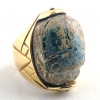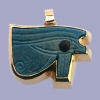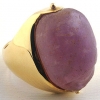|
Ancient Jewelry
|
|
 |
|
 |
|

Price :
$4200.00
Origin: Israel
Circa: 1600 BC to 1100 BC
Collection: Egyptian Scarabs
Style: Scarab Ring
Condition: Fine
By far the most important amulet in ancient Egypt was the More »
Origin: Israel
Circa: 1600 BC to 1100 BC
Collection: Egyptian Scarabs
Style: Scarab Ring
Condition: Fine
By far the most important amulet in ancient Egypt was the scarab, symbolically as sacred to the Egyptians as the cross is to Christians. Based upon the dung beetle, this sacred creature forms a ball of dung around its semen and rolls it in a large ball over the sand dropping it into its burrow. The female lays her eggs on the ground and covers them with the excrement ball that is consumed by the larvae that emerge in the following days as if miraculously reborn. In the life cycle of the beetle, the Ancient Egyptians envisioned a microcosm of the daily rebirth of the sun. They imagined the ancient sun god Khepri was a great scarab beetle rolling the sun across the heavens. The scarab also became a symbol of the enduring human soul as well, hence its frequent appearance in funerary art. Scarabs of various materials form an important class of Egyptian antiquities. Though they first appeared in the late Old Kingdom (roughly 2575–2130 B.C.), scarabs remained rare until Middle Kingdom times (circa 1938-1600 B.C.) when they were fashioned in great numbers. While some were used as ornaments, others were purely amuletic in purpose. - (MT.118) « Less
|
|
Ancient Jewelry
|
|
|
|
|
| Vendor Details |
Close |
| Contact Info : |
| Barakat Gallery |
| 405 North Rodeo Drive |
| Beverly Hills |
| California-90210 |
| USA |
| Email : barakat@barakatgallery.com |
| Phone : 310.859.8408 |
|
|
|
|
|
|

Price :
$9000.00
Origin: Israel
Circa: 1550 BC to 1250 BC
Collection: Jewelry
Style: Scarab Ring
Medium: Gold, Faience
Condition: Very Fine
By far the most important amulet in ancient More »
Origin: Israel
Circa: 1550 BC to 1250 BC
Collection: Jewelry
Style: Scarab Ring
Medium: Gold, Faience
Condition: Very Fine
By far the most important amulet in ancient Egypt was the scarab, symbolically as sacred to the Egyptians as the cross is to Christians. Based upon the dung beetle, this sacred creature forms a ball of dung around its semen and rolls it in a large ball over the sand dropping it into its burrow. The female lays her eggs on the ground and covers them with the excrement ball that is consumed by the larvae that emerge in the following days as if miraculously reborn. In the life cycle of the beetle, the Ancient Egyptians envisioned a microcosm of the daily rebirth of the sun. They imagined the ancient sun god Khepri was a great scarab beetle rolling the sun across the heavens. The scarab also became a symbol of the enduring human soul as well, hence its frequent appearance in funerary art. Scarabs of various materials form an important class of Egyptian antiquities. Though they first appeared in the late Old Kingdom (roughly 2575–2130 B.C.), scarabs remained rare until Middle Kingdom times (circa 1938-1600 B.C.) when they were fashioned in great numbers. While some were used as ornaments, others were purely amuletic in purpose - (DAC.081) « Less
|
|
Ancient Jewelry
|
|
|
|
|
| Vendor Details |
Close |
| Contact Info : |
| Barakat Gallery |
| 405 North Rodeo Drive |
| Beverly Hills |
| California-90210 |
| USA |
| Email : barakat@barakatgallery.com |
| Phone : 310.859.8408 |
|
|
|
|
|
|

Price :
$3600.00
Origin: Egpyt
Circa: 1600 BC to 1100 BC
Collection: Jewelry
Style: Egyptian Scarab Rings
Medium: Gold, Amethyst
The sacred beetle of ancient Egypt, the scarab is an More »
Origin: Egpyt
Circa: 1600 BC to 1100 BC
Collection: Jewelry
Style: Egyptian Scarab Rings
Medium: Gold, Amethyst
The sacred beetle of ancient Egypt, the scarab is an emblem of the creator, Khepera. The word kepher denotes Being, Existence, Creation, or Becoming, and the god Kephera is the self-existent maker of all things. The worship of the scarab, which is symbolic of resurrection and fertility, dates from the earliest period of civilization in Egypt. Carved scarabs served two major functions: as amulets with protective and religious powers, and as personal seals, which designated the property and authority of the individual whose name was placed upon them. In both cases, the power ascribed to the scarab was very great—in life they served as the signature of their owner and were thought to bring prosperity, and in the afterlife they ensured rebirth through eternity. - (CK.0579) « Less
|
|
Ancient Jewelry
|
|
|
|
|
| Vendor Details |
Close |
| Contact Info : |
| Barakat Gallery |
| 405 North Rodeo Drive |
| Beverly Hills |
| California-90210 |
| USA |
| Email : barakat@barakatgallery.com |
| Phone : 310.859.8408 |
|
|
|
|
|
|

Price :
Contact Dealer
Circa: 1600 BC to 1100 BC
Collection: Egyptian
Style: Beaded Jewelry
Medium: Faience-Gold
Additional Information: sold
Most ancient Egyptian beads were made of faience, More »
Circa: 1600 BC to 1100 BC
Collection: Egyptian
Style: Beaded Jewelry
Medium: Faience-Gold
Additional Information: sold
Most ancient Egyptian beads were made of faience, a glass-composite glaze which was introduced as early as the Pre-Dynastic period. According to Egyptologists, most beads were made on an axis, probably of thread, which would burn up during firing, leaving a hole. Disc, ring and tubular beads were made by coating the axis with the unfired body-paste, rolling the cylinder to an even diameter on a flat surface, and then scoring it with a knife into sections of the desired length. Other shapes, such as ball beads, were rolled between the hands and perforated while still wet with a stiff point such as a wire needle. The beads were then dried, coating with glaze (if the glaze had not already been mixed with the paste), and fired. The firing process often gave the beads a beautiful translucent quality. The majority of faience beads are blue or green in color, but black, red yellow and white ones were also produced, especially in the New Egyptian Kingdom. - (FJ.1218) « Less
|
|
Ancient Jewelry
|
|
|
|
|
| Vendor Details |
Close |
| Contact Info : |
| Barakat Gallery |
| 405 North Rodeo Drive |
| Beverly Hills |
| California-90210 |
| USA |
| Email : barakat@barakatgallery.com |
| Phone : 310.859.8408 |
|
|
|
|
|
|

Price :
Contact Dealer
Origin: Sinai, Egypt
Circa: 1600 BC to 1100 BC
Collection: Egyptian Antiquities
Style: Egyptian
Medium: Faience, Gold
Additional Information: SOLD
Most ancient Egyptian More »
Origin: Sinai, Egypt
Circa: 1600 BC to 1100 BC
Collection: Egyptian Antiquities
Style: Egyptian
Medium: Faience, Gold
Additional Information: SOLD
Most ancient Egyptian beads were made of faience, a glass-composite glaze which was introduced as early as the Pre-Dynastic period. According to Egyptologists, most beads were made on an axis, probably of thread, which would burn up during firing, leaving a hole. Disc, ring and tubular beads were made by coating the axis with the unfired body-paste, rolling the cylinder to an even diameter on a flat surface, and then scoring it with a knife into sections of the desired length. Other shapes, such as ball beads, were rolled between the hands and perforated while still wet with a stiff point such as a wire needle. The beads were then dried, coating with glaze (if the glaze had not already been mixed with the paste), and fired. The firing process often gave the beads a beautiful translucent quality. The majority of faience beads are blue or green in color, but black, red yellow and white ones were also produced, especially in the New Egyptian Kingdom. - (FJ.1229) « Less
|
|
Ancient Jewelry
|
|
|
|
|
| Vendor Details |
Close |
| Contact Info : |
| Barakat Gallery |
| 405 North Rodeo Drive |
| Beverly Hills |
| California-90210 |
| USA |
| Email : barakat@barakatgallery.com |
| Phone : 310.859.8408 |
|
|
|
|
|
|

Price :
Contact Dealer
Origin: Egypt (Sinai)
Circa: 1900 BC to 1100 BC
Collection: Egyptian
Medium: Faience
Additional Information: SOLD
Most ancient Egyptian beads were made of faience, a More »
Origin: Egypt (Sinai)
Circa: 1900 BC to 1100 BC
Collection: Egyptian
Medium: Faience
Additional Information: SOLD
Most ancient Egyptian beads were made of faience, a glass-composite glaze which was introduced as early as the Pre-Dynastic period. According to Egyptologists, most beads were made on an axis, probably of thread, which would burn up during firing, leaving a hole. Disc, ring and tubular beads were made by coating the axis with the unfired body-paste, rolling the cylinder to an even diameter on a flat surface, and then scoring it with a knife into sections of the desired length. Other shapes, such as ball beads, were rolled between the hands and perforated while still wet with a stiff point such as a wire needle. The beads were then dried, coating with glaze (if the glaze had not already been mixed with the paste), and fired. The firing process often gave the beads a beautiful translucent quality. The majority of faience beads are blue or green in color, but black, red yellow and white ones were also produced, especially in the New Egyptian Kingdom. - (FJ.2416) « Less
|
|
Ancient Jewelry
|
|
|
|
|
| Vendor Details |
Close |
| Contact Info : |
| Barakat Gallery |
| 405 North Rodeo Drive |
| Beverly Hills |
| California-90210 |
| USA |
| Email : barakat@barakatgallery.com |
| Phone : 310.859.8408 |
|
|
|
|
|
|

Price :
Contact Dealer
Origin: Israel
Circa: 1600 BC to 1100 BC
Collection: Egyptian Scarab Ring
Medium: Faience/Gold
Additional Information: SOLD
Origin: Israel
Circa: 1600 BC to 1100 BC
Collection: Egyptian Scarab Ring
Medium: Faience/Gold
Additional Information: SOLD « Less
|
|
Ancient Jewelry
|
|
|
|
|
| Vendor Details |
Close |
| Contact Info : |
| Barakat Gallery |
| 405 North Rodeo Drive |
| Beverly Hills |
| California-90210 |
| USA |
| Email : barakat@barakatgallery.com |
| Phone : 310.859.8408 |
|
|
|
|
|
|

Price :
Contact Dealer
Origin: Lebanon (Heliopolis)
Circa: 1600 BC to 1100 BC
Collection: Egyptian Amulet Pendant
Medium: Faience/Gold
Additional Information: SOLD
Origin: Lebanon (Heliopolis)
Circa: 1600 BC to 1100 BC
Collection: Egyptian Amulet Pendant
Medium: Faience/Gold
Additional Information: SOLD « Less
|
|
Ancient Jewelry
|
|
|
|
|
| Vendor Details |
Close |
| Contact Info : |
| Barakat Gallery |
| 405 North Rodeo Drive |
| Beverly Hills |
| California-90210 |
| USA |
| Email : barakat@barakatgallery.com |
| Phone : 310.859.8408 |
|
|
|
|
|
|

Price :
Contact Dealer
Origin: Egypt (Sinai)
Circa: 1600 BC to 1100 BC
Collection: Egyptian
Medium: Faience-Amber
Additional Information: Sold
This unusual necklace brings together amber and More »
Origin: Egypt (Sinai)
Circa: 1600 BC to 1100 BC
Collection: Egyptian
Medium: Faience-Amber
Additional Information: Sold
This unusual necklace brings together amber and faience, two of the ornaments most prized by the ancients. Faience, a glass composite glaze, was introduced in Egypt as early as the Pre-Dynastic period. Beads of various sizes and shapes were formed from clay, coated with faience paste and then fired to bright colors. The majority of beads were in shades of blue or green, but red, yellow and black were also popular. In the art of Egypt’s Golden Age, beautiful women are shown adorned with strand after strand of faience beads. Very often, such jewelry was buried in tombs to bring pleasure through eternity. In this lovely necklace, the beads certainly fulfill their promise. Amber, the fossilized resin of extinct trees, is one of the oldest gems known to mankind. Its use as an amulet or for jewelry stretches back to the Stone Age. It was traded throughout the ancient world along routes that led from the north to the palaces of Crete, Egypt and Babylon. Homer mentions amber in the Odyssey. In color, amber varies in hue from pale yellow, to honey brown, to deep orange, to red. Combined here with Egyptian Faience, Amber helps create a Jewel that the Queen of Sheba, Nefertite or Helen of Troy might have warn with pride. - (FJ.3866) « Less
|
|
Ancient Jewelry
|
|
|
|
|
| Vendor Details |
Close |
| Contact Info : |
| Barakat Gallery |
| 405 North Rodeo Drive |
| Beverly Hills |
| California-90210 |
| USA |
| Email : barakat@barakatgallery.com |
| Phone : 310.859.8408 |
|
|
|
|
|
|

Price :
Contact Dealer
Origin: Egypt (Luxor)
Circa: 1600 BC to 1100 BC
Collection: Egyptian Scarab Ring
Medium: Amethyst/Gold
Additional Information: SOLD
Perhaps no single object better More »
Origin: Egypt (Luxor)
Circa: 1600 BC to 1100 BC
Collection: Egyptian Scarab Ring
Medium: Amethyst/Gold
Additional Information: SOLD
Perhaps no single object better embodies the mystery and magic of ancient Egypt than the scarab. Representing the sacred desert beetle, scarabs were used by king and commoner alike as amulets of good fortune and prosperity. Certain scarabs also functioned as personal seals which designated the property and authority of the person whose name appears on them. An emblem of Kephera, the creator, the scarab was worshiped from the earliest period of civilization in Egypt. In addition to its aura of luck, the scarab represented eternal life and resurrection. The ancient Egyptians frequently wore the scarab as jewelry, especially in rings, bracelets and necklaces. This splendid example is carved in amethyst, a gem much favored by the nobility. Its pale lavender color evokes dawn in the Egyptian desert. To wear a scarab today is to link us with Egypt at the height of her grandeur. It also invites the accumulated good fortune of centuries to smile upon us, as it did upon its ancient owner. - (FJ.4856) « Less
|
|
Ancient Jewelry
|
|
|
|
|
| Vendor Details |
Close |
| Contact Info : |
| Barakat Gallery |
| 405 North Rodeo Drive |
| Beverly Hills |
| California-90210 |
| USA |
| Email : barakat@barakatgallery.com |
| Phone : 310.859.8408 |
|
|
|
|
|
|
|
|

|


